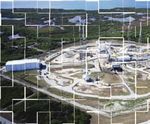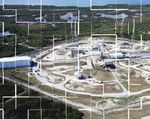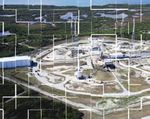The incredible journey of SpaceX
←
→
Page content transcription
If your browser does not render page correctly, please read the page content below
The incredible journey of
SpaceX
In 2002, SpaceX burst onto the launch scene making incredible
promises that included bringing the price of satellite launches down
and to revolutionize space technology – and they are proving it. With
several impressively successful missions under its belt, this company looks
like it will be a force to be reckoned with. GMC looks more closely at
SpaceX and how it could shake up the launch industry and turn government
customers’ heads.
When Elon Musk, creator of PayPal, entrepreneur and engineer, founded a new company that promised
to revolutionise access to space, it is probably fair to say that there were more than a few raised eyebrows.
However, today, any doubters will be finding themselves eating their words, as SpaceX goes from one
success to another. The company has successfully carried out the first ever successful re-supply mission by
a commercial company to the International Space Station, followed by a return to earth with return cargo. It
has also achieved its highest leap yet with its Grasshopper reusable rocket prototype. Furthermore, the
company has just successfully carried out its first commercial launches to LEO and GEO orbit. In just 12
short years, these are impressive feats and SpaceX’s ambitions do not end here. With CEO and Chief
Engineer Musk eyeing a mission to Mars with its eventual colonisation, this is serious stuff.
The vision
SpaceX has an ultimate goal – and that is to enable people to live on other planets, but in the meantime, the
company is looking to revolutionize space technology. So what does that mean? Firstly, the company is
heavily focused upon bringing the cost of launching satellites down. Commercial satellite operators have
long been disgruntled by high launch prices and have bitterly complained that, combined with insurance and
other costs, placing a satellite in orbit is far too expensive. SpaceX caused a stir when the company emerged
onto the launch scene, by openly displaying the cost of launching a satellite with them on their website. This
was something that had not been done before and it attracted a great amount of attention, not least because
the prices were fixed. This new, open approach was a real departure from the approach that satellite
operators were used to. To send a satellite into orbit on the Falcon 9 costs $56.5 million.
The Falcon 9 rocket is now fully operational and has carried out several missions to date, including two
commercial satellite launches. SpaceX is currently developing the Falcon Heavy, which will become the
world’s most powerful rocket. Furthermore, the company is also developing the Grasshopper, a 10 storey
vertical takeoff vertical landing vehicle that is designed to test the technologies required to return a rocket
back to earth intact.
Photo courtesy of SpaceX
www.globalmilitarycommunications.com 20
spacex.pmd 20 3/2/2014, 8:11 PMSpaceX is also passionate about sending people into space on a regular basis, and their Dragon
spacecraft, that performs docking with the ISS for the re-supply mission contract with NASA, is
crew-ready.
Reusability
Elon Musk said: “If one can figure out how to effectively reuse rockets just like airplanes, the cost of
access to space will be reduced by as much as a factor of a hundred.” Reusability is going to be key
to lower the cost of access to space. The majority of the cost of any launch mission goes on the
manufacture of the rocket. If rockets can be made reusable, the cost of a launch could be dramatically
reduced.
SpaceX’s Grasshopper is a prototype Vertical Takeoff Vertical Landing (VTVL) vehicle that
consists of a Falcon 9 first stage and a Merlin 1D engine, four steel landing legs and a steel support
structure. SpaceX’s rockets are built to withstand re-entry into the Earth’s atmosphere in order to be re-
used and also to return to the launch pad for a vertical landing. The Grasshopper is a crucial part of this
development.
The Grasshopper’s most recent jump – the highest yet – was 325 meters, after which it made a precision
landing back to the launch pad. The aim is to continue to attempt higher altitude flights with an eventual
hover at 1,000 meters with engine shutdown and re-start.
The facilities
One of the greatest advantages that SpaceX has over its competition is complete control over all of its
manufacturing. Everything manufactured for the SpaceX program happens at the SpaceX manufacturing
facility in Hawthorne, Texas.
Now that the Falcon 9 has gone into
commercial service as well as taking on the
NASA re-supply missions for the
International Space Station, SpaceX has
increased production on its upgraded Falcon
9 vehicle. More than 70 percent of each
Falcon launch vehicle is manufactured or
assembled at the Hawthorne production
facility, which allows SpaceX to avoid the
pitfalls associated with single-source parts
dependency and gives the company
competitive advantages in quality, cost and
schedule control.
To accommodate this high production
rate, the facility’s manufacturing footprint has
more than doubled to almost one million
square feet. SpaceX produces more rocket
engines than any other US manufacturer and
Photo courtesy of SpaceX the SpaceX factory is one of the largest
manufacturing facilities in California—large
enough to fit two complete Falcon 9s end-
to-end along the short length of the building. With a floor plan designed around mass production, the
factory is already set up to eventually achieve a pace of forty cores annually.
SpaceX tests its engines and structures at a 920-acre state-of-the-art rocket development facility in
McGregor, Texas. Every Merlin engine that powers the Falcon 9 rocket and every Draco thruster that
controls the Dragon spacecraft is tested on one of 11 test stands. On the tripod test stand, the largest stand
at 82 meters (269 feet) tall, the Falcon 9 first stage is tested with all nine Merlin engines firing at 1.3 million
pounds of thrust for up to three minutes—the same as actual flight duration. All Falcon 9 flight structures
are also tested on a 160-foot stand to simulate actual flight loads and pressures. In addition, the facility is
home to a dual Merlin test stand consisting of two independent engine testing bays, allowing SpaceX to
test up to 400 Merlin engines a year. Established in 2003, the site now averages two tests per day.
Launch sites
SpaceX has two launch sites located at Cape Canaveral Air Force Station (CCAFS) in Florida and
Vandenberg Air Force Base (VAFB) in California. Each location offers key benefits to support customer’s
missions.
The Cape Canaveral site, on the southeast coast of the US, provides access to a wide range of low and
medium inclination orbits frequently used by communications and Earth-observing satellites and by supply
missions to the International Space Station. The site also allows access to geostationary orbits, as well as
departures to the Moon and interplanetary destinations. Situated on Cape Canaveral Air Force Station,
with Patrick Air Force Base to the south and NASA’s Kennedy Space Center to the north, SLC-40 benefits
from many support services in the region, including security and launch range control, weather monitoring,
ground support infrastructure, payload processing facilities, and long-range tracking cameras capable of
observing launches from liftoff through stage separation and second-stage ignition out over the Atlantic.
The Vandenberg Air Force Base location on the California coastline provides customers with access to
high inclination and polar orbits, frequently used by satellite communication constellations, defense
intelligence and Earth-observing satellites, and some lunar missions. Launches from Vandenberg heading
21 www.globalmilitarycommunications.com
spacex.pmd 21 3/2/2014, 8:11 PMstraight south traverse open ocean all the way to the Antarctic, by which time the vehicles have long
since reached orbit. SpaceX’s operations at SLC-4E benefit from Vandenberg‘s security and launch
range control, weather monitoring, ground support infrastructure, payload processing facilities, and
long-range tracking cameras capable of observing launches from liftoff through stage separation and
second-stage ignition over the Pacific.
Threat to the United Launch Alliance
The question on people’s lips now will be whether SpaceX can launch a competitive assault on the
United Launch Alliance. SpaceX is now at the stage where the company can gain certification to
launch sensitive government satellites. After three successful launches, the company can qualify for
the US Air Force’s Evolved Expendable Launch Vehicle (EELV) program. At present, almost all
government missions are flown on the Atlas 5 and Delta 4 rockets, but SpaceX firmly believes that
the company can save the government a significant amount of money on launches as compared to its
current reliance on the ULA – around $1 billion per year.
Certification will take around three months to complete as the involved process will take into account
technical assessments and audits of the launch vehicle and its systems and the launch sites and ground
systems.
In June 2013, SpaceX and the US Air Force signed an agreement allowing cooperative Research and
Development with a view to certifying the Falcon 9 for military launches. The Air Force is currently looking for
another launch service provider to counter the dominance of the ULA.
In December 2013, SpaceX won contracts for the launch of two Air Force satellites – the Deep Space
Climate Observatory (to launch in 2014) and experimental satellites for the Air Force’s Space Test Program
(to launch in 2015). Though both for the US Air Force, these were not critical missions and did not require
certification. However, for national security space missions, certification is necessary. Nevertheless, SpaceX
has established a good foundation for future work with the US Air Force, and if certified, the company will
most certainly be a direct competitor to the ULA.
The emergence of SpaceX as a launcher of critical military and government missions is significant and
could potentially upset the existing status quo in terms of the ULA’s monopoly.
It has been reported that Lockheed Martin has expressed concern over SpaceX’s inexperience and
criticised the company, saying that the lower launch costs offered by SpaceX means that they are cutting
corners by cutting costs on the rocket. Elon Musk has hit back, saying that the 21st century technology used
in Falcon 9 is more powerful, and the advances have enabled them to build the rocket for less cost. The
challenge by a young usurper is perhaps bound to rub the ULA up the wrong way.
The Falcon 9
The Falcon 9 launch vehicle has recently gone through an upgrade. The Falcon 9 is a two stage rocket
specifically designed by SpaceX to facilitate the reliable and cost-efficient transportation of satellites and
also the Dragon spacecraft. Promoted as a true 21st century rocket, the Falcon 9 was developed over a four
and a half year period and the new, upgraded version debuted in September 2013 when it launched Canada’s
Cassiope scientific satellite. At present, SpaceX has almost 50 Falcon 9 missions on its manifest – both
commercial and government and military.
The Falcon 9 has been designed for maximum reliability. It features a simple two-stage design to minimize
the number of stage separations that have, historically, been a main cause of launch failures. The Falcon 9
features nine engines on the first stage which means that it can safely complete its mission even in the event
of a first stage engine failure.
Falcon 9 stands at 224.4 feet tall and 12 feet in diameter. The nine first-stage Merlin engines generate
1.3 million pounds of thrust, rising to 1.5 million pounds of thrust as Falcon 9 climbs out of the Earth’s
atmosphere.
From the very start, the Falcon 9 was designed to transport crew to space, and this is something that the
company hopes to make a regular reality in coming years. But for now, SpaceX continues to strive to maintain
its 100 percent launch record with five successful launches to date.
The Falcon 9 anatomy
First Stage - Falcon 9 tanks are made of aluminium-lithium alloy, a material made stronger and lighter than
aluminium by the addition of lithium. Inside the two stages are two large tanks each capped with an aluminium
dome, which store liquid oxygen and rocket-grade kerosene engine propellants. The tanks and domes are
fabricated entirely in-house by SpaceX. Sections of aluminium are joined together using SpaceX’s custom-
made friction stir welders to execute the strongest and most reliable welding technique available. The structures
are painted in-house by SpaceX, concurrent with the welding process.
Falcon 9’s first stage incorporates nine Merlin engines. After ignition, a hold-before-release system ensures
that all engines are verified for full-thrust performance before the rocket is released for flight. Then, with
thrust equal to greater than five 747s at full power, the Merlin engines launch the rocket to space. Unlike
airplanes, a rocket’s thrust actually increases with altitude. Falcon 9 generates 1.3 million pounds of thrust at
sea level but gets up to 1.5 million pounds of thrust in the vacuum of space. The first stage engines are
gradually throttled near the end of first-stage flight to limit launch vehicle acceleration as the rocket’s mass
decreases with the burning of fuel.
Interstage - The interstage, which connects the first and second stages, is a composite structure made of
sheets of carbon fibre and an aluminium honeycomb core, and it holds the release and separation system.
Falcon 9 uses an all-pneumatic stage separation system for low-shock, highly reliable separation that can
www.globalmilitarycommunications.com 24
spacex.pmd 24 3/2/2014, 8:11 PMbe tested on the ground, unlike pyrotechnic systems used on most launch vehicles.
Second Stage - The second stage, powered by a single Merlin vacuum engine, delivers Falcon 9’s
payload to the desired orbit. The second stage engine ignites a few seconds after stage separation,
and can be restarted multiple times to place multiple payloads into different orbits. For maximum
reliability, the second stage has redundant ignition systems. Like the first stage, the second stage is
made from a high-strength aluminium-lithium alloy, using most of the same tooling, materials, and
manufacturing techniques. This commonality yields significant design and manufacturing efficiencies.
Merlin 1D Engine - The Merlin engine that powers the first stage of Falcon 9 is developed and
manufactured in-house by SpaceX . Burning liquid oxygen and rocket-grade kerosene propellant, a
single Merlin engine emits 654 kilonewtons (147,000 pounds) of thrust at lift-off, rising to 716
kilonewtons (161,000 pounds) as it climbs out of Earth’s atmosphere. Merlin’s thrust-to-weight ratio exceeds
150, making the Merlin the most efficient booster engine ever built, while still maintaining the structural
and thermal safety margins needed to carry astronauts.
Falcon 9 is the only vehicle currently flying with engine out capability; Falcon 9 can lose up to two of its
Merlin engines on the first stage and still complete its mission. The nine-engine architecture on the first
stage is an improved version of the design employed by the Saturn I and Saturn V rockets of the Apollo
program, which had flawless flight records in spite of engine losses.
The Merlin 1D engine provides a number of improvements over its Merlin 1C predecessor, including
greater performance, improved manufacturability by using high efficiency processes, increased robotic
construction and reduced parts count.
High-pressure liquid oxygen and kerosene propellant are fed to each engine via a single-shaft, dual-
impeller turbopump operating on a gas generator cycle. Kerosene from the turbopump also serves as the
hydraulic fluid for the thrust vector control actuators on each engine, and is then recycled into the low-
pressure inlet. This design eliminates the need for a separate hydraulic power system, and eliminates the
risk of hydraulic fluid depletion. Kerosene is also used for regenerative cooling of the thrust chamber and
expansion nozzle.
Octaweb - The Octaweb thrust
structure of the nine Merlin engines
Photo courtesy of SpaceX improves upon the former 3x3
engine arrangement, increasing
the Falcon 9’s reliability while
streamlining its manufacturing
process. It houses the nine Merlin
1D engines and was designed to
handle the increase in thrust from
the Merlin 1C to Merlin 1D engine
design.
The new layout also provides
individual protection for each
engine, and further protects other
engines in case of an engine failure.
With this design, Falcon 9 is also
prepared for reusability – the
Octaweb will be able to survive the
first stage’s return to Earth post-
launch.
Reliability
When developing the Falcon 9,
SpaceX looked very carefully at
launch failures between 1980 and
1999 through an analysis that was
carried out by the Aerospace
Corporation. This revealed that the
majority of historic failures were
attributable to engine failure, stage
separation failure and avionics. In
order to avoid the most common
reasons for failure – engine failure
and stage-separation failure - the
SpaceX engineering team decided
to cluster nine Merlin engines
together to power the first stage.
This enables the Falcon 9 to
sustain an engine failure, yet still
complete its mission. The decision
to do this was based on the Saturn
25 www.globalmilitarycommunications.com
spacex.pmd 25 3/2/2014, 8:11 PM1 and Saturn V rockets of NASA’s Apollo program. The Falcon 9 also has just two stages, which
dramatically reduces the problems associated with separation.
In order to address any problems with avionics, SpaceX has a complete hardware simulator of
the Falcon 9’s avionics in its Hawthorne factory. This allows SpaceX to check nominal and off-
nominal flight sequences and to validate the data that will be used to guide the rocket.
The Falcon 9 is also equipped with a hold-before-release system—a capability required by
commercial airplanes, but not implemented on many launch vehicles. After the first-stage engines
ignite, Falcon 9 is held down and not released for flight until all propulsion and vehicle systems are
confirmed to be operating normally. An automatic safe shutdown occurs and propellant is unloaded
if any issues are detected.
Challenging what’s possible
With an infectious ‘can do’ attitude, SpaceX certainly is changing the way in which we look at launching
satellites but it’s not just that – it is changing the way we look at access to space. What may have seemed like
science fiction until recently, now seems to be attainable and this forward thinking company is pushing the
boundaries on a daily basis.
In offering a lower cost alternative to commercial and government and military entities, SpaceX could
very well mean big changes in the launch sector. The company’s open attitude and huge enthusiasm for the
job in hand is palpable – these people really do want to change the launch industry. The innovation currently
being carried out by the company is critical in the development of re-usable vehicles that will bring launch
prices down. However, until this is made possible, SpaceX continues to offer a lower cost alternative to the
other providers on the market, yet without any compromise on reliability. It is probably fair to say that the
company has had its fair share of sceptics and there was a period of ‘will they won’t they’ as we watched and
waited for the first launches of the Falcon 9. However, with its 100 percent record, its commercial launch life
beginning, and a very full manifest stretching ahead to 2018, SpaceX is certainly a force to be reckoned
with.
Can the US government and military afford to ignore what SpaceX can do for them? Definitely not. As
the company moves closer to certification for the launch of national security space programs, the dominance
of the ULA for US government and military launches is being threatened, and how they will attempt to
counter that remains to be seen. Can SpaceX be referred to as an underdog? No. The fact is that no matter
how you look at it, every launch service provider must start somewhere. The fact that SpaceX are taking a
different, bold, pro-active, and perhaps fearless approach could be perceived as a threat by those in direct
competition. Change is not well-received - and SpaceX is at the forefront of pushing through a revolution in
access to space. I am sure we will all continue to be fascinated by its journey.
Photo courtesy of SpaceX
www.globalmilitarycommunications.com 26
spacex.pmd 26 3/2/2014, 8:12 PMYou can also read



























































